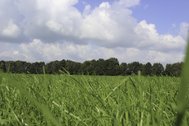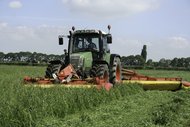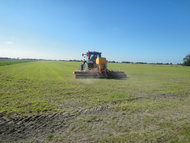Five reasons why it pays to invest in good grassland now in 2015
1. Good grass is always cheaper than concentrates.
The cost price of fresh grass and silage is much lower than the price of concentrates. (Fresh grass € 0.07, silage € 0.15 and concentrates € 0.23 per kilo dry matter). Substituting grass for concentrates in the feed ration saves a lot of money : € 58 a year for each cow when two kilos concentrates are replaced by grass silage, € 117 a year for each cow when two kilos of concentrate are replaced by two kilos fresh grass.
 2. The more grass in the daily ration, the lower the cost price.
2. The more grass in the daily ration, the lower the cost price.
All financial reports show that farmers who put a high proportion of grass in the daily ration have the lowest cost price per litre milk. Take Ireland as an example: this country has the lowest costs in Europe because milk is produced from cows that graze on fresh grass. By replacing 20% of maize silage by grass silage, a farm can make a saving of no less than € 60 a year for each cow. In this case too, the advantage is even greater when fresh grass is used instead of silage.
See table 1. Effect of increased content grass silage in a feed ration’
 3. Keep more money in your pocket : Growing grass is cheaper than growing maize.
3. Keep more money in your pocket : Growing grass is cheaper than growing maize.
The costs of grass cultivation are much lower than those of maize with savings of approximately € 300/ha in the case of cutting and up to € 650/ha in the case of grazing. By choosing to sow grass instead of maize this spring, the farmer can keep more money in his pocket this year. "A penny saved is a penny earned."
See table 2. Difference in operational costs of grass versus maize cultivation
 4. Overseeding immediately increases yield and saves the costs of renewing grassland.
4. Overseeding immediately increases yield and saves the costs of renewing grassland.
According to research carried out in Germany, regular overseeding gives an increased yield of more than 11,402 MJ NEL/ha/year. That means a return of more than € 200 per hectare. Furthermore, overseeding keeps the sward free of weeds and bare patches, meaning that there is less need to renew grassland. Savings for the present and the future.
See table 3. Overseeding trial results by ‘Landwirtschaftskammer Niedersachsen, Germany 2004 – 2008.
 5. Making a small investment in difficult times will more than pay itself back when times are good.
5. Making a small investment in difficult times will more than pay itself back when times are good.
During a recession, it sometimes seems that it makes sense to choose the cheapest product, but that often turns out to be very expensive. The best recommended varieties easily bring a higher return of € 400 per hectare.

